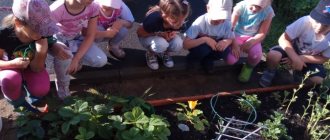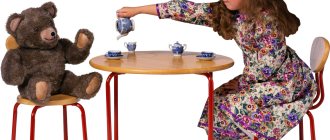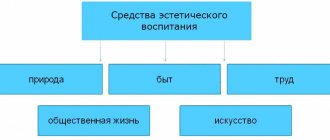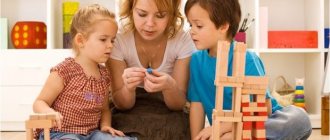MAGAZINE Preschooler.RF
“Project activity as a way to form an ecological culture among children of senior preschool age”Everything good in people comes from childhood! How to awaken the origins of goodness? Touch nature with all your heart: Be surprised, learn, love! We want the earth to bloom, And babies to grow like flowers, So that for them ecology becomes Not a science, but a part of the soul!
S. Nikolaeva
Changes in socio-economic conditions in the life of society, a lack of culture of communication and relationships create certain difficulties in the formation of a child’s social orientation. In this regard, modern trends in pedagogical science are aimed at personal development. Based on the Priority National Project “Education”, the main task of which is the modernization of Russian education, it is necessary to introduce innovative forms of working with children into teaching practice.
In the modern world, environmental problems have become of paramount importance. An urgent task has become the adoption of decisions and measures to protect the environment from pollution and destruction, preserving the entire genetic diversity of living beings, and preserving the gene pool of the planet. Scientists around the world have agreed that environmental problems and disasters are associated with the education of the population - its insufficiency or absence has given rise to a consumerist attitude towards nature. Gaining ecological consciousness and thinking is the only way out of this situation for humanity. It is necessary to form a new type of person, with new ecological thinking, capable of realizing the consequences of his actions in relation to the environment and able to live in relative harmony with nature. Caring for nature should be the norm of behavior for people of any age.
Therefore, in the current conditions, the task of environmental education of the world's population has arisen. Primary importance is attached to the environmental education of the younger generation. The global problems of our time require an immediate rethinking of the historically established attitude in human consciousness aimed at a consumer attitude towards nature, a change not only in its behavior, but also a change in value orientations. Our planet can only be saved by human activity, based on a deep understanding of the laws of nature, taking into account the numerous interactions in its communities, and the understanding that man is not the ruler of nature, but a part of it. In other words, an environmental problem is not just a problem of environmental pollution and other negative influences, it is the result of human activity on Earth.
That is why one of the most pressing issues of modern society is the problem of forming an ecological culture of the individual. Currently, the formation of an ecological culture among preschool children is becoming a priority in pedagogical theory and practice. Human interaction with nature is an extremely pressing problem of our time. Every year its sound becomes stronger - this is the direction of preschool pedagogy that differs from the traditional introduction of children to nature.
The formation of an environmental culture is environmental knowledge, ecological thinking, environmentally sound behavior and a feeling of love for nature. An ecologically cultural person, when experiencing nature and communicating with it through his feelings (admiration, joy, surprise, tenderness, anger, indignation, compassion, etc.), experiences his attitude towards it and strives to preserve wild nature, thereby showing love for the natural world. The formation of an ecological culture is manifested in an emotionally positive attitude towards nature, the surrounding world, a responsible attitude towards one’s health and the state of the environment, compliance with certain moral standards, and a system of value orientations. This implies the goal of environmental education in preschool educational institutions - the formation of the beginnings of environmental culture in children, the development of environmental consciousness, thinking, and environmental culture in adults (educators, parents) raising them.
At preschool age, the prerequisites are created for the formation of personality, the character of a future citizen, and the development of intellectual and communicative competence. Therefore, it is in preschool age that it is necessary to lay in pupils the foundations of moral and intellectual personal development, a positive attitude towards nature, towards the “man-made world” , towards themselves and the people around them. Introducing a child into the world of nature, forming realistic ideas - knowledge about its objects and phenomena - are the most important tasks of a kindergarten. This problem can be easily solved using the project method. This method develops the ability to focus one’s attention on objects in the immediate environment and phenomena of the surrounding reality, the ability to compare, analyze, establish simple cause-and-effect relationships, identify certain properties in objects, and group them.
Sukhomlinsky V.A. wrote that it is necessary to cultivate in a child a love “for everything that cannot live without a gentle human hand, without a sensitive human heart. It’s about love for the living and defenseless, the weak and tender .
1. 1. Justification of relevance.
From birth, a child is a discoverer, an explorer of the world that surrounds him. Everything is new for him: sun and rain, clear water and green grass, white snow and fluffy clouds. After all, a child with his desire to learn, with tireless curiosity and with an inventive, creative imagination receives joy and satisfaction from contact with nature. We adults must notice in time and support children's cognitive interest, help the child see the beauty of the world, instill in him confidence in his abilities and ignite the flame of creativity and joy of life.
In contact with nature, not only cognitive interest develops, but the child’s personality is formed. Objects of nature attract preschoolers, first of all, with their beauty, bright colors, variety, and this is the source of the first concrete knowledge and joyful experiences, often remembered for a lifetime. The influence of nature on a child is enormous.
Children come into contact with its objects or phenomena every day in one form or another:
- on walks they watch birds and insects;
- watching falling snowflakes;
- listen to poems, stories;
- At home they watch TV programs about the animal and plant world of the Earth;
- care for plants in a corner of nature.
Environmental education and upbringing of children is an extremely pressing problem of the present time. The formation of a system of elementary scientific environmental knowledge that is understandable to preschoolers is the main goal of environmental education. In the process of achieving this goal, the following tasks are solved:
- formation in preschoolers of a conscious attitude towards nature, its phenomena and objects;
- development of ecological thinking and creative imagination in the process of experimental and research activities of children;
- formation of skills and abilities to observe living and inanimate objects of nature;
- mastering basic norms of behavior in relation to the natural world and the surrounding world as a whole.
- Formation of ideas about your body and a healthy lifestyle.
Currently, new trends and problems are visible in the field of ecology, indicating the need to take environmental education to a qualitatively new level and improve technologies and teaching methods. Teachers are faced with the task, already at preschool age, of developing in children the skills of independence, activity, initiative in finding answers to questions, collecting information, experimenting and applying acquired knowledge, skills and abilities.
This approach makes it possible to implement the project method (project method). The special pedagogical significance of the project lies in the practical purposefulness of actions, in the possibility of forming a child’s own life experience based on his interests. The project allows you to integrate information from different fields of knowledge to solve a problem and apply it in practice. Participation in environmental events, community cleanups, landscaping, and work on environmental projects is a unique opportunity for children and parents to express themselves and benefit the environment.
The introduction of the project activity method into practice has become one of the main means of developing the ecological culture of preschool children. The inclusion of preschoolers in project activities allows them to develop an independent and responsive personality, develops creativity and intellectual abilities, promotes the formation of determination, perseverance, teaches them to overcome emerging difficulties and problems, and communicate with peers and adults. Since it is difficult for children to independently find contradictions in their surroundings, formulate a problem, and determine the goal (intention) of a project in the educational process, project activities are in the nature of cooperation, in which children and teachers take part, as well as parents and other family members. The experience of independent activity gained by a child in preschool develops his self-confidence.
In our preschool educational institution, long-term annual planning is developed according to thematic blocks. Each block includes specific topics: “Water” , “Air” , “Birds” , “Wild Animals” , “Trees” , “Flowers” , etc. All educational activities are directly aimed at the topic being studied; they can last one or several weeks. Summarizing the material covered, we identify the problem of environmental content and this becomes the basis for working on a project on this topic. With children of senior preschool age, together with their parents, the following projects were developed and presented: “Visiting the Trees” , “Our Feathered Friends” , “Green Helpers” , “Fire-Friend, Fire-Enemy” and others. The results of joint work on projects were presented in the form of the creation of environmental signs with environmental content, the publication of an environmental newspaper, the involvement of all participants in the pedagogical process and their parents in environmental actions, and the defense of the project was carried out using information computer technologies. Undoubtedly, such work arouses great interest among children and parents, and learning becomes of better quality.
Thus, taking into account the above advantages of this method, the need arose to develop the Project: “Project activities as a way to form an environmental culture in children of senior preschool age .
Object of project activity: children of senior preschool age.
Subject of project activity: organizational and pedagogical conditions that contribute to the formation of an ecological culture among older preschoolers.
By time: long-term (2013-2015 academic year).
Main goal of the project:
Using the project activity method as a way to develop ecological knowledge about nature, the foundations of ecological culture, and consciously correct behavior in nature in children of senior preschool age.
Hypothesis: the use of the project method in the educational process for children of senior preschool age will contribute to:
Increasing the level of environmental knowledge and culture of behavior in nature.
Objectives of the pedagogical project:
- Formation of search and research activities and intellectual initiative through the project method.
- Development of initiative, curiosity, arbitrariness, and the ability for creative self-expression.
- Formation of knowledge about objects of living and inanimate nature, nurturing a caring attitude towards all living things on Earth.
- Abstract part. Theoretical justification of the project.
- 1. Environmental education of preschool children.
Nature leaves a deep imprint on a child’s soul, influencing his feelings with its brightness, diversity, and dynamism. Children discover a new world for themselves: they try to touch everything with their hands, look at it, smell it, if possible, taste it. Preschoolers look at the world around them with great interest, but they don’t see everything, sometimes they don’t even notice the main thing. You need to have patience, an attentive eye and a sensitive soul to see the quiet beauty of a tiny wildflower or the play of colors during sunset, the wild bloom of lilacs, or listen to the ringing singing of birds. And if there is a teacher nearby who wonders with them, who teaches them not only to look, but also to see, the children will want to learn even more.
Preschool age is an important stage in the formation of environmental ideas, which are the basis of ecological knowledge about the natural environment and respect for it, as well as the formation of a consciously correct attitude of children towards natural objects with which they are in direct contact.
Environmental education is carried out using methods that allow preschoolers to demonstrate the adaptability of plants and animals to their environment, the dependencies that exist in natural communities, the connection between man and nature, and the results of the impact of his activities on the nature of his immediate environment. These methods include:
- systematic observation,
- orderly recording of observations,
- directed communication,
- labor in nature,
- modeling activity,
These methods are more traditional. A good help is the project method, which opens up a lot of opportunities for the full environmental education of preschoolers.
2. 2. Using the project method in educational practice.
Environmental projects open up the opportunity to shape a child’s own life experience and, based on his needs and interests, develop him as a person. The special pedagogical significance of the project method lies in the fact that it opens up the possibility of forming a child’s own experience of interacting with the outside world. It is a pedagogical technology that determines the child’s own position in the pedagogical process; it is a method that comes from children’s needs and interests, age and individual characteristics of children. This is one of the few methods that takes the pedagogical process out of the walls of a children's institution into the surrounding world, the natural and social environment. In addition, the project method contributes to the development of many qualities of the child and their practical application in interaction with the outside world.
The use of the project method in educational practice contributes to the formation of many personal qualities:
- independence. When implementing a project, children begin to pre-plan their actions and their time; the child learns to take into account the interests of other people, which reduces the number of contradictions and disputes. The child learns to make his choice of specific actions, his behavior based on predicting its consequences;
- creativity. In the process of project activities, children create a new product (drawing, costume model, scenery, album, etc.). Creativity characterizes both the final product and the nature of the activity process. “A child’s creativity depends on the level of development of his thinking, imagination, volition, as well as the breadth of orientation in the environment and awareness” ;
- initiative. During the project, the child builds his communication with peers and adults, experiments, organizes games;
- leadership. The development of the leadership potential of preschoolers is facilitated not only by the content component, but also by the ways of interaction between children and adults in the process of project implementation, including various forms of communication (business, cognitive, personal).
All of the listed qualities, the development of which is facilitated by the project method, to one degree or another form the basis of the social competence of a preschooler.
The project is implemented in a playful way, involving children in various types of creative and practically significant activities, in direct contact with various objects of the social environment (excursions, meetings with people of different professions, practically useful things). The project method, as mentioned above, is associated with developing person-centered learning and can be widely used in preschool educational institutions, in working with children of senior preschool age. The project allows you to integrate information from different fields of knowledge to solve one problem and apply it in practice.
Basic requirements for using the project method in kindergarten:
- At the heart of any project is a problem that requires research to solve.
- The project is a “serious game” , the results of which are significant for children and adults.
- Mandatory components of the project are children's independence (with the support of a teacher), co-creation of children and adults, the development of children's communication abilities, cognitive and creative skills, and the application of acquired knowledge by preschoolers in practice.
Project stages:
- Preparatory - setting goals and objectives, determining research methods, preparatory work with teachers and preschoolers, selecting and preparing equipment and materials. You should not set too distant tasks for children, offer distant prospects, or demand that you cover several areas of activity at the same time.
- Actually, research is the search for answers to the questions posed.
- The final stage is a generalization of the results of the work, their analysis, and formulation of conclusions.
Projects can be short-term or long-term; their duration is determined depending on the tasks being solved. The project can be considered as an addition to any general development, comprehensive and environmental programs.
Experience in a preschool educational institution confirms that the use of the project method in the educational process helps to increase the interest of preschoolers in educational activities. This method develops the individual and collective activities of children and enables the teacher to implement a person-oriented approach to each child. Project activities are used to introduce children to natural objects in order to create motivation and accumulate knowledge when communicating with nature, broadening their horizons, which certainly improves the educational process and creates positive motivation for self-education. Project topics can be very diverse depending on the identified problem.
2. 3. Degree of novelty.
Novelty of the innovative project:
Project activity is presented as a person-oriented technology that can be used in working with students in almost any area. A new form of organization of training and education contributes to the development of the student’s personality, optimization of the educational process and increases the effectiveness of training.
The use of project activities in kindergarten practice is considered as a pedagogical innovation, since the basis of the project method is the idea of directing the cognitive activity of preschoolers towards the result that is achieved in the process of joint work of the teacher and children on a specific practical problem (topic).
While working on a project, already in preschool age, such qualities as independence, activity, and initiative in finding answers to questions are formed. Collecting information, experimenting and applying the acquired knowledge, skills and abilities in games and practical activities.
III. Project part.
3. 1. Development of criteria and level characteristics for assessing the effectiveness of pedagogical interaction.
In order to monitor the effectiveness of the implemented project “Project activities as a way to form an environmental culture in children of senior preschool age,” methods for assessing the expected results have been developed.
| Next > |






